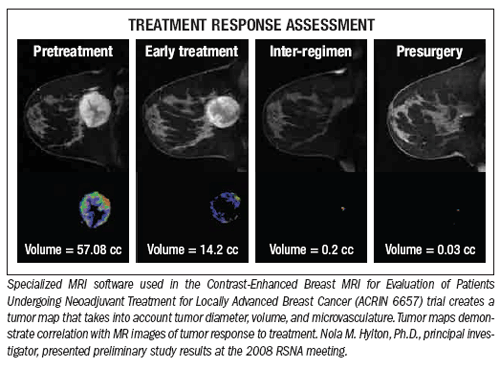Depth increases in lineupof breast imaging options
Breast imaging remained a strong point of scientific research at the 2008 RSNA meeting, with breast MRI playing a starring role but sharing the limelight with tomosynthesis, position emission mammography, and breastspecific gamma imaging.
Nola Hylton, Ph.D., and colleagues showed preliminary results from American College of Radiology Imaging Network trial 6657. It found that MRI measures residual breast cancer disease more accurately than clinical exams or mammography.
Hylton, a professor of radiology at the University of California, San Francisco, and colleagues examined 216 patients at eight institutions. The measures helped predict the breast tumors’ response to neoadjuvant chemotherapy.
Women with invasive breast cancer measuring 3 cm or greater who received an anthracycline-cyclophosphamide (AC) neoadjuvant chemotherapy regimen followed by a taxane were enrolled between May 2002 and March 2006. Contrastenhanced MRI was performed at baseline, following one AC cycle, between AC and taxane treatment, and after taxane treatment but prior to surgery.
Following neoadjuvant chemotherapy, MRI is more accurate than clinical exams or mammography for estimating residual disease and predicting response to treatment, said Hylton, director of the Magnetic Resonance Science Center at UCSF.
Not only did the ACRIN trial use breast MRI, but a study out of Ohio demonstrates the modality can have a positive impact on clinical decision making for black women with newly diagnosed breast cancer.
Few studies have addressed if and how breast MRI affects how black women make clinical decisions, said Dr. Laura Shepardson, a radiologist at The Cleveland Clinic.
A total of 306 African American patients had a breast MR exam at The Cleveland Clinic between 2003 and 2007. Of these, 111 (36%) with newly diagnosed ductal carcinoma in situ, invasive ductal carcinoma, or invasive lobular carcinoma were included in Shepardson’s study. The women in the study had no prior history of radiotherapy or chemotherapy.
The treatment was breast conservation in 58% of cases (64 women) and mastectomy in 42% (47).
Radiotherapy was performed in 64% of cases (71 women), chemotherapy in 48% (53), and endocrine therapy in 43% (48). In 13% of cases (14 women), the MR exam prompted a negative second-look ultrasound and/or negative biopsy. These falsepositive findings may partly reflect a learning curve for the interpreting radiologists.

Breast MRI dominated breast research, but other modalities, like breast tomosynthesis, also made an appearance.
Breast tomosynthesis detects lesions with even greater sensitivity than breast MRI, which may also be its downfall, according to one researcher.
“We end up seeing every fibroid adenoma and every cyst when we markedly increase our detection of otherwise benign lesions,” said Dr. Jay A. Baker, director of breast imaging at Duke University, during his keynote speech at the RSNA meeting.
Increasing the number of detected benign lesions becomes problematic because, ultimately, the detection does not aid the patient. The hope that tomosynthesis will reduce the overall number of recalls depends on clarifying architectural distortions that on diagnostic examination turn out to be nothing more than overlapping but normal breast tissue, he said.
A modality that shows similar sensitivity and specificity to breast tomosynthesis but is also readily available in the U.S. is positron emission mammography (PEM).
“[PEM] gives us great clarity and confidence in diagnosing new cancers,” said Dr. Kathy Schilling, the lead researcher and director of breast imaging and intervention at the Center for Breast Care at Boca Raton Community Hospital in Florida.
PEM is especially useful for women with dense breasts, according to Schilling. While breast MRI is a good technique for detecting cancer in women with dense breasts, the test is limited by a high incidence of false positives, she said. Additionally, breast MRI is much less effective when patients are imaged at an inappropriate point during their menstrual cycle.
False-positive results are often attributed to the effects of hormones in the patient.
Breast density and hormonal status will not affect PEM sensitivity or specificity when screening for cancer because the technique uses the metabolic differences between cancer cells and normal cells to distinguish between them.
A method that also zeroes in on the metabolic function of cancer is breastspecific gamma imaging (BSGI).
BSGI detects cancer cells that escape the notice of mammograms and physical exams, according to research presented at RSNA by Dr. Rachel Brem, a professor of radiology at The George Washington University Medical Center in Washington, DC.
Brem’s team of researchers examined the records of 159 women who underwent BSGI after their mammograms or clinical exams revealed one or more suspicious or cancerous lesions.
Gamma imaging revealed at least one more suspicious lesion in 29% of them.
At least half the occult cancers detected in the study were smaller than 1 cm, but Brem said gamma imaging can detect early lumps as small as 1 mm.
AI-Initiated Recalls After Screening Mammography Demonstrate Higher PPV for Breast Cancer
March 18th 2025While recalls initiated by one of two reviewing radiologists after screening mammography were nearly 10 percent higher than recalls initiated by an AI software, the AI-initiated recalls had an 85 percent higher positive predictive value for breast cancer, according to a new study.